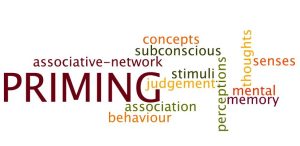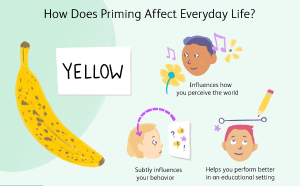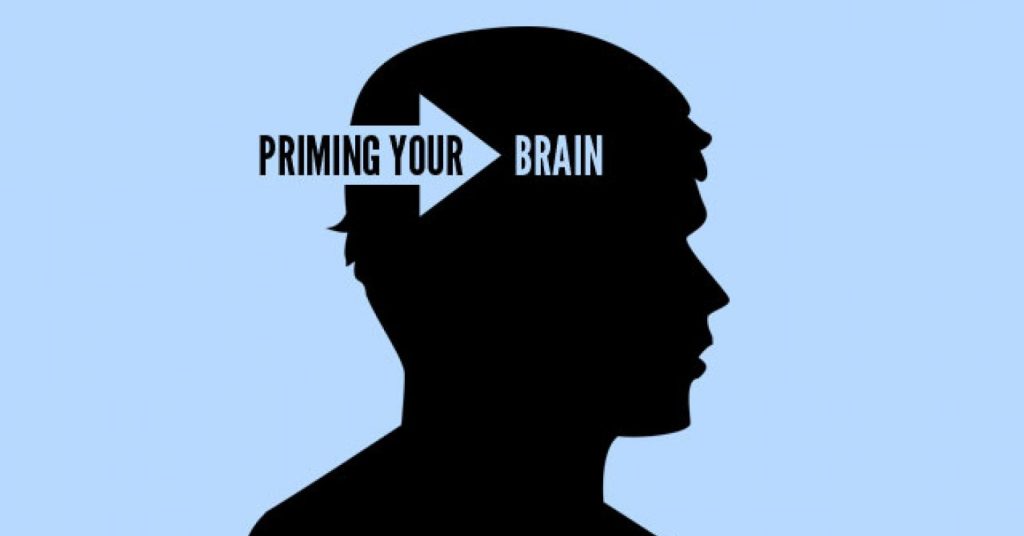Contents
What Is Priming?

The psychological process of priming is the act of reading the mind to perform a specific task. By priming the brain with certain cues, we can improve our performance on subsequent tasks. For example, research has shown that people who are primed with words related to intelligence perform better on cognitive tests.
Priming is a psychological process in which the mind is readied to perform a task by providing it with certain cues or stimuli. It is a phenomenon in which one stimulus influences how the brain responds to another. On a cognitive and emotional level, priming works on both levels of processing. The aim of priming is generally to make people believe or feel something without knowing why. And making them more susceptible to persuasion later with little effort on the part of the persuader.
How To Prime Your Brain?

There are ways you can prime your brain. like-
Stimulus
There are a number of ways to prime the brain for a task. One common method is to provide a stimulus that is associated with the task at hand. For example, if you are taking a math test, you might be shown a picture of a calculator before beginning the exam. This type of priming is known as semantic priming.
Perceptual Priming
Perceptual Priming is when your brain is aware of what is being primed. For example, you are more likely to notice the word, “orange” in one passage when it follows the word, “fruit”. Your brain is aware that fruit means orange and this is due to your conscious perception of these words.
Implicit Priming
Implicit Priming is when your brain does not know it is being primed. For example, you are more likely to respond to the word “red” in one passage when it follows the word, “green”. The brain recognizes this relationship without conscious awareness because green means red subconsciously based on your previous experience with these words.
Enactment priming
Another way to prime the brain is through enactment priming. This involves actually performing a task before being tested on it. For example, if you are taking a math test and have been shown a picture of a calculator beforehand, you might be asked to actually use the calculator during the exam. Enactment priming has been found to improve performance on tests involving motor skills as well as cognition.
Priming is also used in advertising. Advertisements often try to prime the brain by presenting a commercial for an unrelated product immediately before showing an ad for their product.
Semantic Priming
One way to prime the brain is through semantic priming. Semantic priming involves providing a stimulus that is associated with the task at hand, such as showing a picture of a calculator just before taking a math test. Semantic priming uses associations between concepts to facilitate memory retrieval.
Advertising often uses semantic and enactment priming in an attempt to prime the brain of its target audience. Advertisements often show a commercial for an unrelated product just before showing an ad for their own product, attempting to link their brand with something positive.
How Does Priming Work?

Priming is a psychological process that occurs when the mind is prepared to complete a task by providing it with certain cues or stimuli. There are two main types of it and how it works: semantic and enactment.
Semantic priming involves providing a stimulus that is associated with the task at hand, such as showing a picture of a calculator prior to taking a math test.
Enactment priming, on the other hand, involves performing an action before being tested on it. Advertisements often make use of both types of priming in order to prime the brain of their target audience.
Priming has been found to improve performance on tests involving motor skills as well as cognition. One way advertising often uses priming is by showing a commercial for an unrelated product just before showing an ad for their own product. By linking their brand with something positive, they prime the brain of their consumers to feel good about buying from them.
Semantic and enactment priming often occur in conjunction with one another during advertisements that involve enactments. The enactments may prime the target audience to better understand intended semantic messages.
How Priming Affects Memory and Behavior?

The idea that priming can affect behavior is supported by the fact that semantic and enactment priming occurs in advertising, where related actions often elicit certain responses from the target audience. For example, an advertisement for a beer brand may show people drinking their product while also showing attractive models at a party. The beer company is trying to link the product with sex, pleasure, and good times.
Activates Specific Representation
Priming of this sort affects memory without our awareness of it. Because it activates specific representations in memory that are then help to guide behavior or judgments. One study shows that people whose brain prime the words related to being old walked more slowly after participating in the experiment than those who were prime with neutral words.
Through Imaging
The effects of priming can be long-lasting and/or subtle, yet important. A recent study showed that even a single exposure to an image related to the elderly could affect people’s ability to accurately perform memory tasks, such as recalling details from a story they read earlier. These findings suggest that priming may influence our thoughts and behavior without us even knowing it.
Priming can affect memory, people’s ability to perform tasks or judgments, as well as the way we think about others. It is an implicit process that occurs outside of our awareness because semantic and enactment primes change the way our brain represents information in memory. The result is that we use these representations when performing certain tasks or making judgments, and we do so without realizing we’ve been primes in the first place.
The Effects of Priming

On the one hand, priming helps to improve creativity in some cases. On the other hand, it has also link to more prejudiced beliefs in certain studies. The impact of priming is typical and and is according to the type of prime, its strength, and how much time has it been since it’s presentation.
Positive Effects of Priming
- Words and pictures can have a beneficial influence on behavior.
- Prime a person with ideas about intellect, such as “professor,” may lead them to perform better on tests than if the word was not a prime (i.e., just told to determine whether or not what they read was a word).
- Before asking participants for their thoughts on current events, show them pictures of lovely locations to elicit more positive responses than those given by individuals who did not view such stimuli previously.
Negative Effects of Priming
On the other hand, priming also have some negative effects in certain situations. Some people thinks that it also raise aggression in particular circumstances. If someone uses priming on their brain with the idea of hostility before playing a game. Then they are more likely to act violently toward their opponents than those who have no exposure to priming with this notion.
Similarly, framing offenders as social issues beforehand might lead to more conservative answers than those given by people who have not face prime in this way.
Importance Of Priming

Priming is an important psychological process because it affects memory, judgment, and behavior without our awareness. When we are primed with certain concepts or stimuli, our brain is better able to retrieve related information from memory. This can influence the way we think about others, perform tasks, and make judgments. The effects of priming can be long-lasting and subtle, yet they can have a profound impact on our lives.
Helps Memorize
Priming is essential to how we function, especially in a society that often makes use of it. Advertisers prime our brains all the time by linking products with attractive people and pleasurable experiences. While politicians prime us through certain word choices. Primes allow us to function because they activate representations of certain concepts or events in memory. That then affect our thoughts and behaviors.
Influence Customers
Priming is a powerful way to influence how people think and behave. By using priming techniques in your marketing. You can increase the chances that potential customers will have interest in what you have to offer. Priming affects how we think about others, behave, and perform tasks. Advertisers often use priming to their advantage. By linking products with positive feelings or pleasurable experiences to get consumers to buy them. Politicians may prime us through word choice as well, making us feel good about certain ideas and concepts by associating them with certain words.
What Is Priming Used For?
Priming is a technique to influence a person’s thoughts or behavior by presenting them with a stimulus. This stimulus can be in the form of a word, an image, or even an action. The idea behind priming is that when someone exposes us to a certain prime. It will activate related representations in our memory. This, in turn, will affect how we think about others, behave, and also help us perform tasks.
Priming is often helpful for advertisers to get people to buy products. Advertisers often link products with positive feelings or pleasurable experiences to get consumers to buy them. Politicians may also prime us through word choice. That makes us feel good about certain ideas and concepts by associating them with certain words.
Conclusion
Priming is an implicit process that occurs outside of our awareness. It affects memory, people’s ability to perform tasks or judgments, and the way we think about others. Primers can influence memory by activating related concepts in memory. The result is that when someone prime your brain with certain concepts or stimuli, your brain is better able to retrieve related information from memory. It can influence the way you think about others, behave, and perform tasks. It is an important psychological process because it affects memory, judgment, and behavior without your awareness. In this article, we’ve outlined some of the basics of priming and shared some tips for how you can use it to drive more sales. Let us know if you have any questions about how to apply these principles in your own marketing strategy!
A Word From Therapy Mantra
Your mental health — Your psychological, emotional, and social well-being — has an impact on every aspect of your life. Positive mental health essentially allows you to effectively deal with life’s everyday challenges.
At TherapyMantra, we have a team of therapists who provide affordable online therapy to assist you with issues such as depression, anxiety, stress, workplace Issues, addiction, relationship, OCD, LGBTQ, and PTSD. You can book a free therapy or download our free Android or iOS app.


